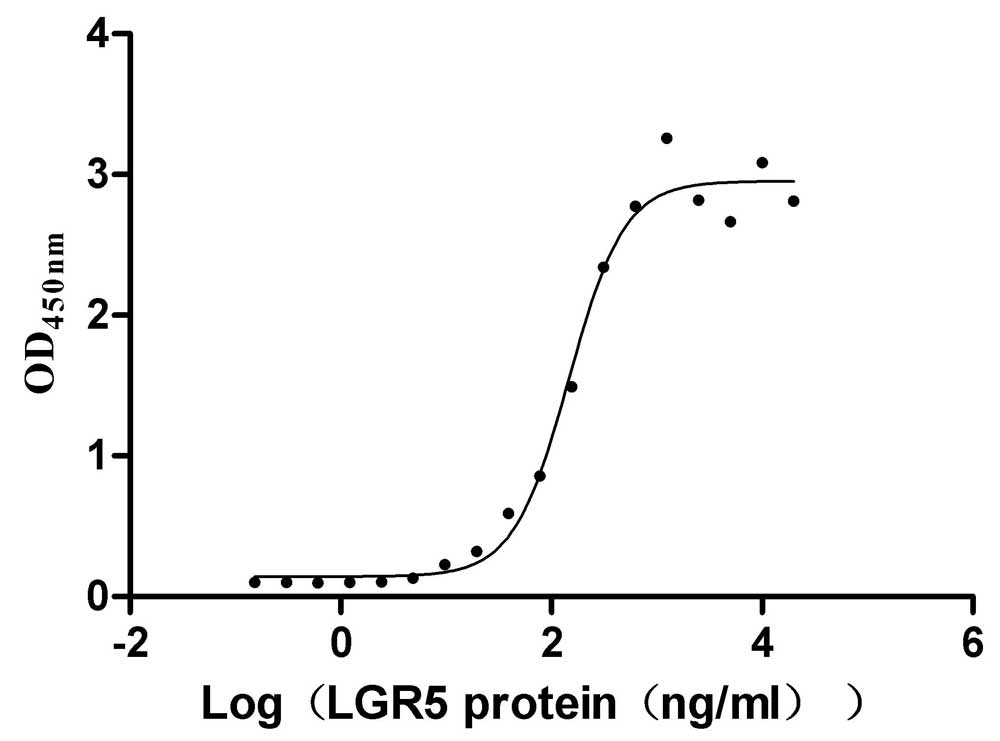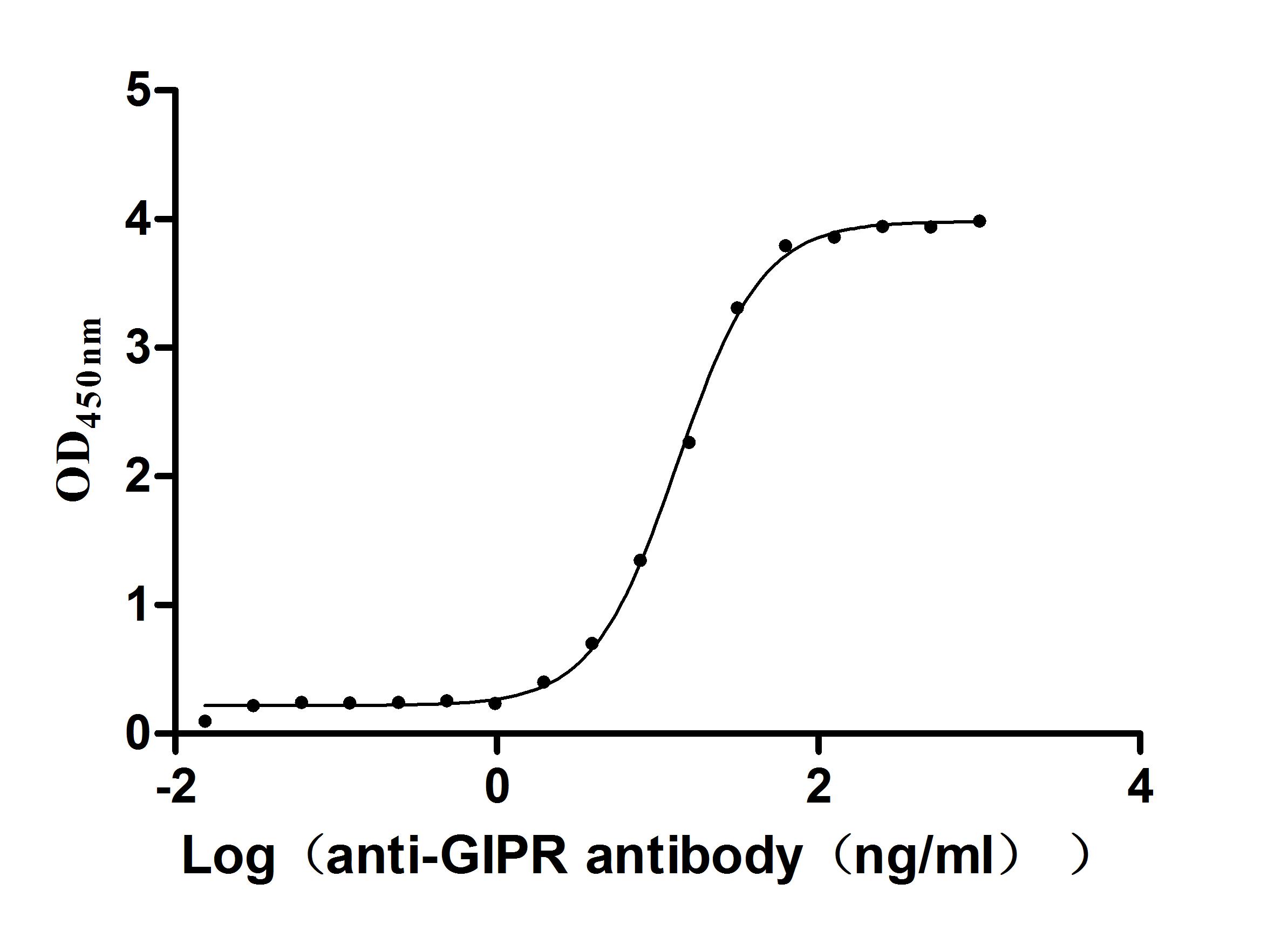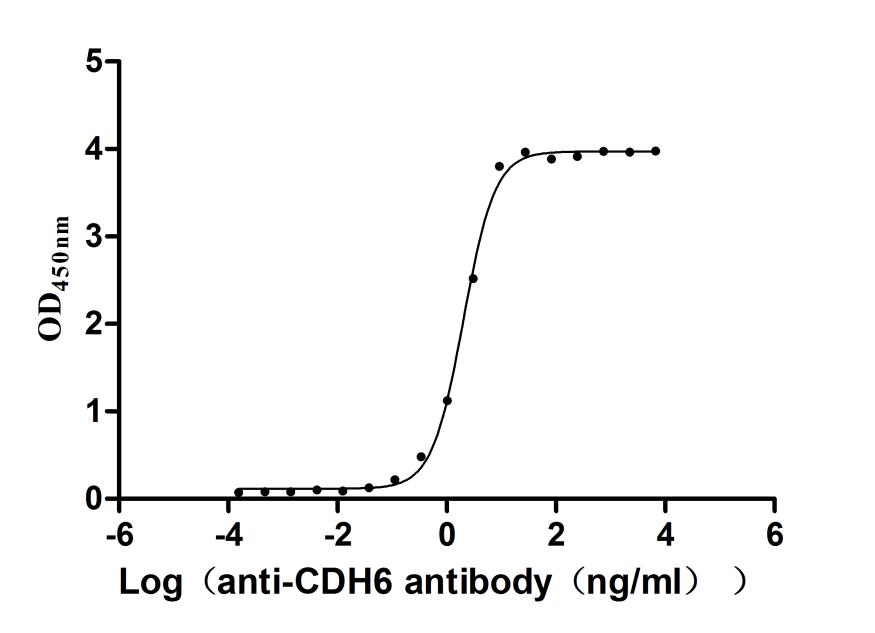Recombinant Human Cytoplasmic polyadenylation element-binding protein 1 (CPEB1)
-
货号:CSB-YP861184HU
-
规格:
-
来源:Yeast
-
其他:
-
货号:CSB-EP861184HU-B
-
规格:
-
来源:E.coli
-
共轭:Avi-tag Biotinylated
E. coli biotin ligase (BirA) is highly specific in covalently attaching biotin to the 15 amino acid AviTag peptide. This recombinant protein was biotinylated in vivo by AviTag-BirA technology, which method is BriA catalyzes amide linkage between the biotin and the specific lysine of the AviTag.
-
其他:
-
货号:CSB-BP861184HU
-
规格:
-
来源:Baculovirus
-
其他:
-
货号:CSB-MP861184HU
-
规格:
-
来源:Mammalian cell
-
其他:
产品详情
-
纯度:>85% (SDS-PAGE)
-
基因名:CPEB1
-
Uniprot No.:
-
别名:CEBP; CPE binding protein 1; CPE BP1; CPE-binding protein 1; CPE-BP1; CPEB 1; CPEB; CPEB-1; CPEB1; CPEB1 protein; CPEB1_HUMAN; Cytoplasmic polyadenylation binding protein 1; Cytoplasmic polyadenylation element binding protein; Cytoplasmic polyadenylation element binding protein 1; Cytoplasmic polyadenylation element-binding protein 1; FLJ13203; h CEBP; h-CEBP; hCPEB 1; hCPEB-1; MGC34136; MGC60106; mKIAA0940; MKIAA0940 protein
-
种属:Homo sapiens (Human)
-
蛋白长度:full length protein
-
表达区域:1-566
-
氨基酸序列MALSLEEEAG RIKDCWDNQE APALSTCSNA NIFRRINAIL DNSLDFSRVC TTPINRGIHD HLPDFQDSEE TVTSRMLFPT SAQESSRGLP DANDLCLGLQ SLSLTGWDRP WSTQDSDSSA QSSTHSVLSM LHNPLGNVLG KPPLSFLPLD PLGSDLVDKF PAPSVRGSRL DTRPILDSRS SSPSDSDTSG FSSGSDHLSD LISSLRISPP LPFLSLSGGG PRDPLKMGVG SRMDQEQAAL AAVTPSPTSA SKRWPGASVW PSWDLLEAPK DPFSIEREAR LHRQAAAVNE ATCTWSGQLP PRNYKNPIYS CKVFLGGVPW DITEAGLVNT FRVFGSLSVE WPGKDGKHPR CPPKGNMPKG YVYLVFELEK SVRSLLQACS HDPLSPDGLS EYYFKMSSRR MRCKEVQVIP WVLADSNFVR SPSQRLDPSR TVFVGALHGM LNAEALAAIL NDLFGGVVYA GIDTDKHKYP IGSGRVTFNN QRSYLKAVSA AFVEIKTTKF TKKVQIDPYL EDSLCHICSS QPGPFFCRDQ VCFKYFCRSC WHWRHSMEGL RHHSPLMRNQ KNRDSS
-
蛋白标签:Tag type will be determined during the manufacturing process.
The tag type will be determined during production process. If you have specified tag type, please tell us and we will develop the specified tag preferentially. -
产品提供形式:Lyophilized powder
Note: We will preferentially ship the format that we have in stock, however, if you have any special requirement for the format, please remark your requirement when placing the order, we will prepare according to your demand. -
复溶:We recommend that this vial be briefly centrifuged prior to opening to bring the contents to the bottom. Please reconstitute protein in deionized sterile water to a concentration of 0.1-1.0 mg/mL.We recommend to add 5-50% of glycerol (final concentration) and aliquot for long-term storage at -20℃/-80℃. Our default final concentration of glycerol is 50%. Customers could use it as reference.
-
储存条件:Store at -20°C/-80°C upon receipt, aliquoting is necessary for mutiple use. Avoid repeated freeze-thaw cycles.
-
保质期:The shelf life is related to many factors, storage state, buffer ingredients, storage temperature and the stability of the protein itself.
Generally, the shelf life of liquid form is 6 months at -20°C/-80°C. The shelf life of lyophilized form is 12 months at -20°C/-80°C. -
货期:Delivery time may differ from different purchasing way or location, please kindly consult your local distributors for specific delivery time.Note: All of our proteins are default shipped with normal blue ice packs, if you request to ship with dry ice, please communicate with us in advance and extra fees will be charged.
-
注意事项:Repeated freezing and thawing is not recommended. Store working aliquots at 4°C for up to one week.
-
Datasheet :Please contact us to get it.
相关产品
靶点详情
-
功能:Sequence-specific RNA-binding protein that regulates mRNA cytoplasmic polyadenylation and translation initiation during oocyte maturation, early development and at postsynapse sites of neurons. Binds to the cytoplasmic polyadenylation element (CPE), an uridine-rich sequence element (consensus sequence 5'-UUUUUAU-3') within the mRNA 3'-UTR. RNA binding results in a clear conformational change analogous to the Venus fly trap mechanism. In absence of phosphorylation and in association with TACC3 is also involved as a repressor of translation of CPE-containing mRNA; a repression that is relieved by phosphorylation or degradation. Involved in the transport of CPE-containing mRNA to dendrites; those mRNAs may be transported to dendrites in a translationally dormant form and translationally activated at synapses. Its interaction with APLP1 promotes local CPE-containing mRNA polyadenylation and translation activation. Induces the assembly of stress granules in the absence of stress. Required for cell cycle progression, specifically for prophase entry.
-
基因功能参考文献:
- These findings indicated that the overexpression of miR4543p inhibited cell proliferation, migration and invasion by downregulating CPEB1. PMID: 30106109
- Upon binding to p27(Kip1) 3'UTR, CPEB1 promotes elongation of poly-A tail and the subsequent translation of p27(Kip1) mRNA. This leads to higher levels of p27(Kip1) in the cell, in turn significantly inhibiting cell proliferation, and confers to CPEB1 a potential value as a tumor suppressor in Glioblastoma. PMID: 27142352
- CPEB1 regulation of MMP9 mRNA expression mediates metastasis of breast cancer cells PMID: 26411364
- The host RNA-binding protein CPEB1 was highly induced after cytomegalovirus infection and ectopic expression of CPEB1 in non-infected cells recapitulated infection-related post-transcriptional changes. CPEB1 was also required for poly(A)-tail lengthening of viral RNAs important for productive infection. PMID: 27775709
- Expression levels of CPEB4 and CPEB1 genes are correlated with overall survival in patients with glioma. PMID: 27000226
- WEE1 is regulated at the translational level by CPEB1 and miR-15b in a coordinated and cell-cycle-dependent manner. PMID: 27027998
- This mechanical catalysis makes possible a positive feedback loop that would help localize the formation of CPEB fibers to active synapse areas and mark those synapses for forming a long-term memory after the prion form is established. The functional role of the CPEB helical oligomers in this mechanism carries with it implications for targeting such species in neurodegenerative diseases. PMID: 27091989
- Structural Analysis of the Pin1-CPEB1 interaction and its potential role in CPEB1 degradation has been described. PMID: 26456073
- Identify a mechanism of VEGF overexpression in liver and mesentery that promotes pathologic, but not physiologic, angiogenesis, via sequential and nonredundant functions of CPEB1 and CPEB4. PMID: 26627607
- CPEB1, 2, and 4, are essential to successful mitotic cell division. PMID: 26398195
- Results suggest that CPEB1-mediated translational control is essential for the differentiation of GSCs. PMID: 25216517
- CPEB accelerates deadenylation and decay of the c-myc mRNA by recruiting the Tob-Caf1 complex. PMID: 23178487
- Downregulation of CPEB1 induces senescence of glioma cells in a p53-dependent manner. PMID: 23788032
- FMRP and CPEB1, an activator of translation, are present in neuronal dendrites, are predicted to bind many of the same mRNAs and may mediate a translational homeostasis that, when imbalanced, results in fragile X syndrome. PMID: 24141422
- The structural similarity to other ZZ domains suggests that the CPEB1-ZZ domain recruits sumoylated proteins during assembly of the ribonucleoprotein complex prior to mRNA export from the nucleus. PMID: 23500490
- results reveal a novel function of CPEB1 in mediating alternative 3'-UTR processing, which is coordinated with regulation of mRNA translation, through its dual nuclear and cytoplasmic functions PMID: 23434754
- poly(A) polymerase Gld2, deadenylase PARN, and translation inhibitory factor neuroguidin (Ngd) are components of a dendritic CPEB-associated polyadenylation apparatus PMID: 22727665
- The first evidence of CPEB1 involvement in GC is presented, along with the molecular mechanism underlying the regulation of its expression and its potential role in invasion and angiogenesis. PMID: 22052064
- CPEB-mediated zonal occludens-1 mRNA localization is essential for tight-junction assembly and mammary epithelial cell polarity PMID: 22334078
- depleted of CPEB demonstrated that this protein directly regulates the translation of PTEN and Stat3 mRNAs. Our results show that CPEB regulated translation is a key process involved in insulin signaling PMID: 22253608
- Gld4, a second non-canonical poly(A) polymerase, was found to regulate p53 mRNA polyadenylation/translation in a CPEB-dependent manner PMID: 21478871
- The loss of function CPEB1 protein would enhance tumorigenesis by promoting the survival of rapidly dividing and hypermetabolic tumor cells as levels of available nutrients decline. PMID: 20339377
- The s show that the human CPEB1 can repress the activity of the reporter construct containing the HPV-16 early sequences. This repression can be counteracted by a human cytoplasmic poly(A) polymerase, hGLD-2 fused to CPEB1. PMID: 20144904
- CPEB1 has a role in compartmentalization of mRNA metabolism in the cytoplasm, between dcp1 bodies and stress granules PMID: 15731006
- Results show that CPEB1 is continuously shuttling between nucleus and cytoplasm, and its export is controlled by two redundant motifs dependent on the nuclear export receptor Crm1. PMID: 18923137
- CPEB controls senescence and bioenergetics in human cells at least in part by modulating p53 mRNA polyadenylation-induced translation PMID: 19141477
- U6snRNA, GAPDH mRNA and CPEB1 mRNA levels may be useful as tumor markers for genital cancers. PMID: 19161537
显示更多
收起更多
-
亚细胞定位:Cytoplasm. Nucleus. Cytoplasm, P-body. Cytoplasmic granule. Cell junction, synapse. Membrane. Cell junction, synapse, postsynaptic density. Cell projection, dendrite.
-
蛋白家族:RRM CPEB family
-
组织特异性:Isoform 1 is expressed in immature oocytes, ovary, brain and heart. Isoform 2 is expressed in brain and heart. Isoform 3 and isoform 4 are expressed in brain. Expressed in breast tumors and several tumor cell lines.
-
数据库链接:
HGNC: 21744
OMIM: 607342
KEGG: hsa:64506
STRING: 9606.ENSP00000457881
UniGene: Hs.459132
Most popular with customers
-
Recombinant Human Tumor necrosis factor ligand superfamily member 14 (TNFSF14), partial (Active)
Express system: Mammalian cell
Species: Homo sapiens (Human)
-
Recombinant Human Tyrosine-protein kinase Mer (MERTK), partial (Active)
Express system: Mammalian cell
Species: Homo sapiens (Human)
-
Recombinant Human IGF-like family receptor 1 (IGFLR1), partial (Active)
Express system: Mammalian cell
Species: Homo sapiens (Human)
-
Recombinant Human Claudin-18.2 (CLDN18.2)-VLPs (Active)
Express system: Mammalian cell
Species: Homo sapiens (Human)
-
Recombinant Human R-spondin-1 (RSPO1), partial (Active)
Express system: Mammalian cell
Species: Homo sapiens (Human)
-
Recombinant Human CD81 antigen (CD81), partial (Active)
Express system: Mammalian cell
Species: Homo sapiens (Human)
-
Recombinant Macaca Gastric inhibitory polypeptide receptor(GIPR), partial (Active)
Express system: yeast
Species: Macaca fascicularis (Crab-eating macaque) (Cynomolgus monkey)
-
Recombinant Mouse Cadherin-6(Cdh6),partial (Active)
Express system: Mammalian cell
Species: Mus musculus (Mouse)





-AC1.jpg)














